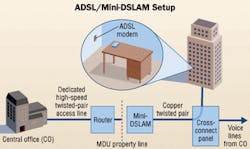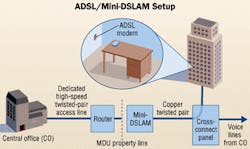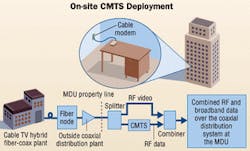Delivering broadband over existing wiring
With on-site edge devices, multiple dwelling units can deliver multiple services to residents.
Successful telecommunications service providers seek to follow the traditional business model: increase revenues by expanding market penetration while minimizing expenses. But competition remains intense. Multiple system operators (MSOs), private cable operators (PCOs), and telecommunications companies are under tremendous pressure to keep costs down by severely limiting new capital expenditures while still offering the newest services.
In-demand services, primarily high-speed Internet access and video, can travel to the consumer over a number of paths, including fiber. But the path of least resistance, requiring minimal capital expenditure while offering maximum profit, is the one that is already in place: coaxial and twisted-pair cable.
Typically, multiple dwelling unit (MDU) complexes, also frequently referred to as multiple tenant unit (MTU) complexes, already deliver voice and data over twisted pair, and basic video services over coaxial cable. But many of today's consumers are increasingly demanding sophisticated broadband services. The least expensive means of delivering high-end services in MDUs is over the existing coaxial/twisted-pair network.
Service providers can penetrate the MDU/MTU market by cost-effectively offering the demanded services, allowing the MDU owner to compete effectively for tenants. And, by delivering these services over the existing network, the provider can meet the new MDU market needs while still minimizing infrastructure investments.
There are two approaches to a typical network's construction. The first option is the traditional telco approach, which concentrates all active electronics in one location-typically, the central office (CO)-and uses a passive distribution network. The second option is to deploy a diversified plant in which the active components are placed at the edge of the network-at the MDU.
In a typical MDU complex, a telecommunications provider usually owns the physical twisted-pair wiring and the access rights of any particular service. The wiring and access rights may be owned by the same company, or by two different companies. A cable TV MSO servicing an MDU property over coaxial most likely has the rights to deliver both data and video. The PCO will usually have video rights, but not data rights. So, to deliver data services, the PCO will have to first renegotiate with the property owner or the current holder of data rights.
To maintain rights to the wiring, the service provider must support additional services mandated by customer requirements. This is done typically by upgrading the infrastructure's throughput capacity. The required capacity to deliver the demanded services over twisted pair is about 6 Mbits/sec, distributed as follows:
- High-speed Internet: 1.5 to 2 Mbits/sec;
- Video on demand (VOD): 4 Mbits/sec.
Currently, the maximum throughput a telco can deliver from the CO to the subscriber's home over twisted pair is 1.5 Mbits/sec. This limitation is due to wiring problems between the CO and the MDU (outside plant), not to wiring problems within the MDU itself. Even the best Digital Subscriber Line (DSL) service offers only one-fourth of the throughput requirement to deliver enhanced services to an MDU.
To date, there typically have been just two options for the MDU service provider looking to add new services. The system operator can add new twisted-pair wiring and create a new local area network (LAN) within the facility. Or, the independent local exchange carrier or MSO can deliver these services over its own networks, in most cases requiring the upgrading of the entire outside-plant infrastructure serving the property.
Today's network edge devices, however, now offer new options to the provider. A local provider at an MDU complex or hotel can use the edge devices to locally "insert" services, using the existing wiring. By locating these new edge devices at the MDU property, the throughput problem of twisted-pair networks, caused by poor wiring from the CO to the subscriber's wall outlet, can be overcome. These edge devices are available for twisted-pair and coaxial networks.
Whether operating a twisted-pair or coaxial infrastructure, service providers want to offer additional services over their existing network using the technology they know how to install and maintain. The service provider with an existing coaxial infrastructure wants to stick with its coaxial network, and the same is true for service providers with twisted-pair networks.
The twisted-pair world
In most MDU/MTUs, the existing twisted-pair network carries voice traffic, while high-speed data is delivered over a direct ADSL line from the CO on a trunked T-1/T-3 with a local LAN distribution on premises. This requires the installation and maintenance of two separate infrastructures.
But the market's newest mini-Digital Subscriber Line Multiplexers (DSLAMs) let the service provider deploy high-speed Internet services and VOD over existing twisted-pair networks within the facility. Unlike a traditional DSLAM located in the CO, the mini-DSLAM is installed on-site near the MDU's crossconnect panel. High-speed Internet is then trunked to the property via any kind of Ethernet transport and fed into the mini-DSLAM via a router, where it is coupled with the voice traffic. The ADSL traffic is transported within the premises, delivering voice, high-speed Internet and VOD, using an ADSL set-top.
The mini-DSLAM is connected to the backbone via a dedicated, high-speed access line, such as fractional T-1, a T-1/T-3 line, wireless or satellite technology. Any telco or alternate service providers can provide these high-speed access lines.
This on-site topology allows delivery of high data rates over the existing twisted-pair network using standard ADSL modems, overcoming ADSL's typical distance limitations. The VOD content is delivered to a local server, such as a large-capacity PC, over Ethernet access. This setup eliminates the need for an individual high-speed access line to every user from the CO.
This application of the new mini-DSLAM technology is already de ployed in Europe, and is showing favorable returns. It's an attractive solution for the provider who has rights to the twisted-pair infrastructure within the MDU property. You can start with data delivery, and scale VOD deployments as needed. Again, all these value-added services can be added and deployed using the existing twisted-pair network within the facility.
The coaxial world
A typical coaxial distribution system in any facility today has a bandwidth of 550 MHz, and is one-way only. A one-way coaxial system can only deliver content or service from the head-end (or central point of the facility) to all the outlets within the facility, and cannot provide high-speed Internet or any interactive service that requires a two-way plant with an active return path.
The challenge for coaxial providers is to create a broadband coaxial distribution system that enables the delivery of high-speed Internet access, and has sufficient bandwidth for video delivery via cable TV and DBS (54 to 2,150 MHz) without requiring replacement of the coaxial network or rewiring the property.
New 2-GHz, two-way broadband high-gain coaxial amplifiers can replace the old actives and create a true coaxial broadband network without requiring new wiring. Once the distribution system is upgraded, the MSO can install a mini-cable modem termination system (CMTS) device that is scaled down to cost-effectively support small networks, such as an MDU complex or hotel.
Traditionally, larger CMTS devices are installed at the cable head-end and serve between 500 and 2,000 subscribers per data channel. With four channels, a typical head-end CMTS serves as many as 8,000 customers. The smaller CMTS device, designed for deployment on the MDU property, has all the features of its "big brother" CMTS, but with only one data channel.
With a modest investment in distribution hardware-typically $10 to $15 per home passed and the cost of the CMTS, which is less than $10,000-a sophisticated two-way, 2-GHz coaxial distribution system can be put in place without rewiring or renovating the property. This network is capable of delivering all the following services together to any customer on the property:.
- High-speed Internet access with a cable modem using the 5- to 42-MHz return path;
- Full 110 TV analog channels (54-550 MHz);
- Full cable TV digital tier of 250 TV channels (550 to 750 MHz);
- Digital terrestrial TV and HDTV (typical 750 to 860 MHz);
- Full DBS service offering (950 to 2,150 MHz).
By deploying a mini-CMTS, service providers operating a coaxial network can cost-effectively offer highly demanded services over the existing infrastructure. Similarly, by installing the new mini-DSLAMs now available, providers operating a twisted-pair network in an MDU environment can also offer new services economically over its existing network.
Both technologies let service providers use the MDU's existing network and still add the required services to remain profitable and competitive in the MDU market.
Mor Allon is chief executive officer of Ikusi Telecommunications (www.ikusi.com), part of the global Spanish conglomerate IKUSI. Allon has more than 20 years of experience in the telecommunications markets in the U.S. and Israel.


